Nagtipunan
Nagtipunan, officially the Municipality of Nagtipunan (Ilocano: Ili ti Nagtipunan; Tagalog: Bayan ng Nagtipunan), is a 1st class municipality in the province of Quirino, Philippines. According to the 2015 census, it has a population of 23,484 people. [3]
Nagtipunan | |
|---|---|
| Municipality of Nagtipunan | |
 Seal | |
 Map of Quirino with Nagtipunan highlighted | |
OpenStreetMap 
| |
.svg.png.webp) Nagtipunan Location within the Philippines | |
| Coordinates: 16°13′N 121°36′E | |
| Country | |
| Region | Cagayan Valley (Region II) |
| Province | Quirino |
| District | Lone District |
| Founded | February 25, 1983 |
| Barangays | 16 (see Barangays) |
| Government | |
| • Type | Sangguniang Bayan |
| • Mayor | Nieverose C. Meneses |
| • Vice Mayor | Arnel R. Fiesta |
| • Representative | Junie E. Cua |
| • Electorate | 15,002 voters (2019) |
| Area | |
| • Total | 607.40 km2 (234.52 sq mi) |
| Elevation | 409 m (1,342 ft) |
| Population | |
| • Total | 23,484 |
| • Density | 39/km2 (100/sq mi) |
| • Households | 3,979 |
| Economy | |
| • Income class | 1st municipal income class |
| • Poverty incidence | 19.59% (2015)[4] |
| • Revenue | ₱311,146,829.83 (2016) |
| Time zone | UTC+8 (PST) |
| ZIP code | 3405 |
| PSGC | |
| IDD : area code | +63 (0)78 |
| Climate type | tropical rainforest climate |
| Native languages | Ilocano Ilongot Nagtipunan Agta Arta Tagalog |
| Website | www |
As the largest municipality in the province, it occupies a land area of 1,607.40 square kilometers, nearly half of the province itself.
The municipality is known for its natural environment, and is dubbed as the tourism capital of the province of Quirino.
Barangays
Nagtipunan is politically subdivided into 16 barangays.
- Anak
- Dipantan
- Dissimungal
- Guino (Giayan)
- Keat
- La Conwap (Guingin)
- Landingan
- Mataddi
- Matmad
- Ponggo (Urban)
- San Dionisio II
- San Pugo
- San Ramos
- Sangbay
- Wasid
- Asaklat
History
The Municipality of Nagtipunan was formerly a part of Maddela. It was created on February 25, 1983, by virtue of Batas Pambansa No. 345 and approved in a plebiscite held on September 24, 1983.
The town’s name was derived from the native word meaning “convergence point,” in reference to several major tributaries of the Cagayan River in Aurora, Nueva Vizcaya and Qurino meeting at points within this area.
Demographics
| Year | Pop. | ±% p.a. |
|---|---|---|
| 1990 | 9,460 | — |
| 1995 | 12,509 | +5.37% |
| 2000 | 12,217 | −0.51% |
| 2007 | 20,443 | +7.36% |
| 2010 | 22,473 | +3.51% |
| 2015 | 23,484 | +0.84% |
| Source: Philippine Statistics Authority [3] [5] [6][7] | ||
Attractions
Natural attractions include:
- The Cagayan River, one of the cleanest bodies of water in the Philippines, which flows from Barangay San Pugo down to Barangay Ponggo where Tatimbang, Apang, Aguk, Bimmapor and Puctad are found.
- The 50 metres (160 ft) high Mactol Falls, in Barangay San Pugo, is the Cagayan River headwater. It is located 22 kilometres (14 mi) from Pongo (a 2.5-hr. drive) and has a 22 metres (72 ft) deep basin surrounded by rock formations and a forest. It used for swimming and picnicking.
- Victoria Falls, in Barangay Sangbay, is believed to be a source of the Cagayan River which bisects the valley and ends at the Aparri Delta.
- Also found in Nagtipunan is the “Bimmapor,” a rock formation similar to a sunken ship, of which only the upper decks are protruding from the ground.
- The Pusuac cave and watershed in Barangay Ponggo.
References
- Municipality of Nagtipunan | (DILG)
- "Province: Quirino". PSGC Interactive. Quezon City, Philippines: Philippine Statistics Authority. Retrieved 12 November 2016.
- Census of Population (2015). "Region II (Cagayan Valley)". Total Population by Province, City, Municipality and Barangay. PSA. Retrieved 20 June 2016.
- "PSA releases the 2015 Municipal and City Level Poverty Estimates". Quezon City, Philippines. Retrieved 12 October 2019.
- Census of Population and Housing (2010). "Region II (Cagayan Valley)". Total Population by Province, City, Municipality and Barangay. NSO. Retrieved 29 June 2016.
- Censuses of Population (1903–2007). "Region II (Cagayan Valley)". Table 1. Population Enumerated in Various Censuses by Province/Highly Urbanized City: 1903 to 2007. NSO.
- "Province of Quirino". Municipality Population Data. Local Water Utilities Administration Research Division. Retrieved 17 December 2016.